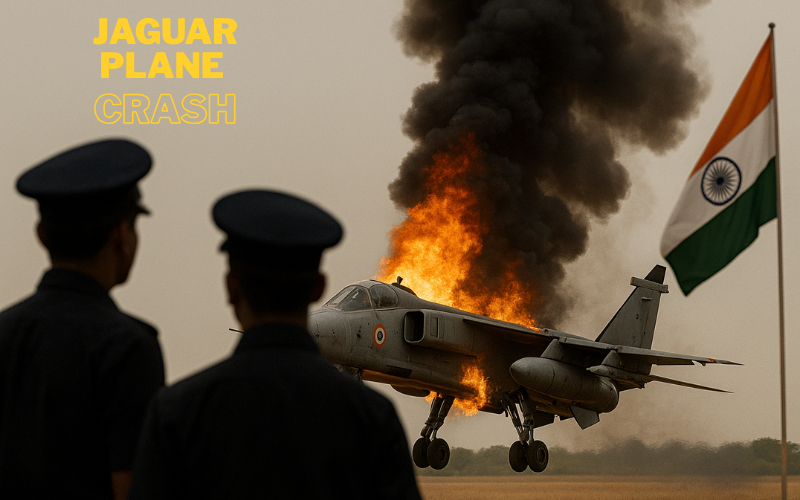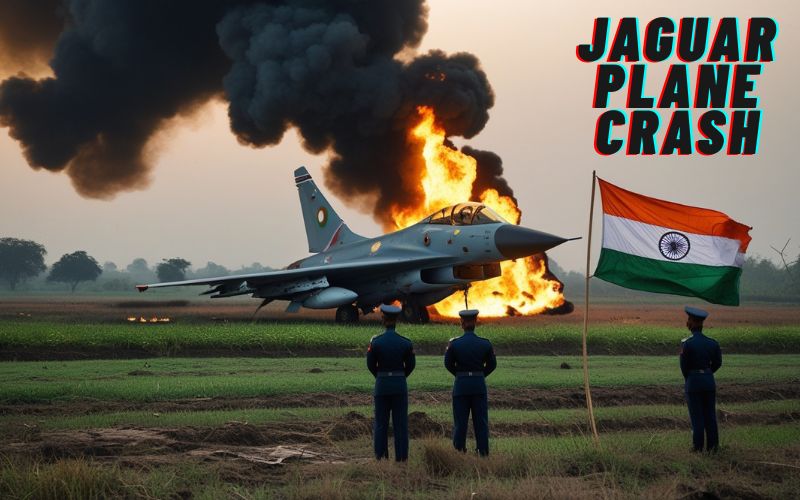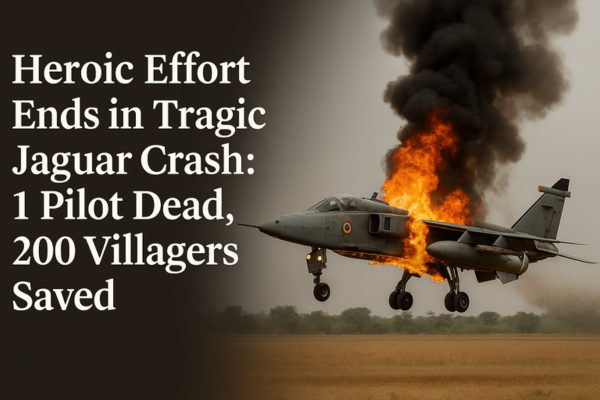Heroic Sacrifice Amid Tragedy: IAF Jaguar Plane Crash Sparks Emotional Outpouring Across India

In a chilling incident that has sent shockwaves across the nation, a Jaguar fighter aircraft of the Indian Air Force (IAF) crashed near a village in Rajasthan on the morning of July 9, 2025. The heartbreaking Jaguar plane crash, which led to the death of a brave pilot, is being hailed not only as a tragic mishap but also as a display of extraordinary courage and self-sacrifice. According to eyewitness accounts and official sources, the pilot made every possible effort to steer the jet away from residential areas, potentially saving the lives of over 200 villagers. The Jaguar plane crash has now become a national moment of mourning and reflection.
The Jaguar plane crash occurred shortly after takeoff from the Jodhpur Airbase. Residents of the nearby village were jolted by a thunderous noise, followed by flames and thick black smoke. One of the pilots managed to eject safely and was later rescued by IAF emergency teams. However, the second pilot tragically lost his life in what many are calling a heroic attempt to avert civilian casualties. The Jaguar plane crash has reignited conversations about the safety of military flight paths near inhabited regions and the risks IAF pilots take during training and combat missions.
Eyewitnesses Recall Final Moments Before Jaguar Plane Crash
As villagers went about their morning chores, few could have imagined the horror that would unfold in seconds. Eyewitness Ramesh Kumar, a local farmer, said, “We saw the aircraft flying unusually low. It looked like it was struggling to stay in the air. Then it suddenly turned, away from our homes, and crashed into a field.” His account matches others in the area, most of whom believe the pilot took last-minute action to divert the aircraft, leading to his own death. The pilot’s sacrifice has added a deeply emotional dimension to the already devastating Jaguar plane crash.
Another villager, Sushila Devi, shared how children were playing just meters away from the eventual crash site. “Had it fallen even a little to the left, it would have hit the school wall,” she said, tears in her eyes. The Jaguar plane crash, while tragic, became a miracle of sorts for those who survived thanks to the pilot’s final maneuver.
Emergency services arrived at the crash site within ten minutes, with IAF teams and local authorities coordinating the evacuation and securing the area. The wreckage of the Jaguar fighter jet lay in smoldering fragments, strewn across the field. Despite the violence of the crash, it is being hailed as a miracle that no villagers were harmed. Still, the psychological scars left by the Jaguar plane crash are expected to linger in the region for years to come.
Local doctors and psychologists have also expressed concern over the long-term emotional impact on children who witnessed the incident. Many families reported their kids having nightmares and experiencing trauma-related symptoms. In response, NGOs and the state education department have launched trauma counseling sessions and support groups. These efforts aim to help restore normalcy and ensure the mental well-being of those affected by the Jaguar plane crash.
The Jaguar Plane Crash Revives Debate on Military Safety Protocols
As news of the Jaguar plane crash spread, defense analysts and aviation experts began to weigh in on the possible causes. Although a court of inquiry has been initiated by the IAF to determine what led to the crash, preliminary insights suggest possible technical failure or bird strike. The aircraft, part of a fleet that has served the Indian Air Force for decades, was on a routine training sortie. This has reignited the debate on whether aging aircraft like the Jaguar should still be in active service.
Experts argue that while Jaguars are still functional and have undergone numerous upgrades, their age makes them more susceptible to issues. Many believe the Jaguar fleet, which was inducted in the 1980s, has outlived its safe operational lifespan. The Jaguar plane crash has led to renewed calls for faster modernization of India’s air fleet. Former IAF officers point out that pilots are often aware of the risks associated with older jets but continue their duties with utmost dedication and professionalism. The courage shown in the Jaguar plane crash is seen as a testament to the selfless spirit of India’s armed forces.
Air Marshal (Retd.) S.P. Singh commented, “Flying outdated aircraft puts our pilots at unnecessary risk. While these machines served us well, the time has come to retire them with honor.” His remarks found resonance among defense circles and civilian observers alike.
Further pressure has mounted from military think tanks urging a thorough audit of all training routes, especially those crossing over populated areas. This crash has made clear that even routine exercises carry immense risks. Aviation safety protocols are being reviewed, and additional emergency response mechanisms are expected to be implemented to avoid similar tragedies in the future.
The Director General of Civil Aviation (DGCA) has been called in to collaborate with the IAF’s inquiry panel to ensure transparency and share learnings that could benefit both military and civil aviation operations. Such cross-domain collaboration is rare but deemed necessary given the potential for civilian harm.
Nationwide Mourning and Tributes After the Jaguar Plane Crash
The deceased pilot has been hailed as a national hero. The Indian Air Force, in a statement, confirmed the loss and paid tribute to the pilot’s courage and quick thinking. Social media platforms were flooded with condolences and tributes from citizens, political leaders, celebrities, and fellow servicemen. The hashtag #JaguarPlaneCrash began trending within hours, with people praising the pilot for what they see as a selfless act of valor.
In villages near the crash site, candlelight vigils and prayer meetings were held. For many, the Jaguar plane crash was not just a tragic news headline—it became a reminder of the silent sacrifices made by those in uniform. Schools and government offices in nearby towns observed a moment of silence, while the state government promised compensation and support to the pilot’s family. The emotional gravity of the Jaguar plane crash has created an atmosphere of unity and sorrow across communities.
Local schools organized tribute assemblies, and drawings depicting the brave pilot began appearing on school walls. Children were seen lighting candles at a makeshift memorial built near the crash site. Such spontaneous acts of remembrance have added to the growing legacy of the Jaguar plane crash.
The Chief Minister of Rajasthan visited the crash site and met with the grieving family. He announced a bravery award in the pilot’s honor and named a government school after him. These symbolic gestures aim to preserve the pilot’s legacy and inspire future generations.
Multiple community leaders across India have echoed the Chief Minister’s initiative by proposing national honors and posthumous awards. A proposal is also in place to install a bronze statue of the pilot in a central square of Jodhpur, to immortalize his contribution.
Media and Public Reactions Intensify Following Jaguar Plane Crash

Television news channels covered the Jaguar plane crash extensively, with round-the-clock reports, live footage from the crash site, and interviews with aviation experts. While the IAF maintained its stance of waiting for inquiry results, public discourse veered toward questions of accountability and the future of aging aircraft in India’s defense strategy.
Journalists reporting from the village described the mood as one of shock, mixed with immense gratitude for the pilot’s final actions. Local newspapers carried front-page stories with headlines emphasizing the pilot’s heroic move to avoid populated areas. Editorials called the Jaguar plane crash a “sobering reminder” of the daily risks undertaken by military personnel. It has also stirred discussion on whether training sorties should be re-routed away from densely populated zones.
Prominent news anchor Ravish Kumar remarked in a broadcast, “In times when headlines are dominated by politics, the story of this pilot reminds us of the real heroes we often overlook.”
Social media influencers and celebrities joined the public in paying their respects. Cricketers, actors, and musicians posted tributes that reached millions, adding to the sense of national unity around the tragedy. The Ministry of Defense posted a special tribute video, viewed over 5 million times within 24 hours.
🚨 Jaguar Plane Crash in Rajasthan: Nation Mourns Loss of Two Brave Pilots
In a tragic incident that has sparked nationwide mourning and renewed debate over aviation safety, a twin-seat Jaguar fighter jet of the Indian Air Force (IAF) crashed in Rajasthan’s Churu district on July 9, 2025. The Jaguar plane crash, which occurred during a routine training sortie, ended in devastation as both pilots onboard lost their lives despite their valiant efforts to steer the aircraft away from civilian areas.
According to the IAF, the fighter jet crash in Rajasthan happened around 1:25 PM in an agricultural field near Bhanoda village. The aircraft had taken off from Suratgarh Air Force Station and was on a scheduled mission when it encountered difficulties mid-air. Eyewitnesses reported that the aircraft caught fire and began losing altitude rapidly before crashing with a thunderous explosion.
Locals described the terrifying scene. “The aircraft was on fire while still in the sky. It tilted away from the village and fell into the fields,” said a villager, praising the pilots for attempting to protect nearby homes. Thanks to their actions, no civilian injuries were reported — a miracle that many attribute to the pilot sacrifice in plane crash.
The Indian Air Force accident was confirmed in a statement expressing “deep regret” over the loss of both air warriors. A formal court of inquiry has been launched to determine the cause of the IAF Jaguar crash, though initial reports suggest a technical failure or mid-air malfunction. Experts have noted the lack of automatic ejection seats in the Jaguar fighter jet, which may have prevented the pilots from escaping safely at low altitude.
This marks the third Jaguar plane crash in 2025, following similar incidents in Panchkula and Jamnagar. Analysts are now raising alarms over the IAF’s continued reliance on aging aircraft. Many argue that the Jaguar fleet, inducted in the 1970s, is well past its prime and must be retired before more lives are lost.
Senior defense officials and aviation experts are calling for the modernization of India’s aerial combat fleet with newer jets like the Tejas Mk1A. Meanwhile, Jaguar fighter jet news continues to dominate headlines as public and political pressure mounts.
Defense Minister Rajnath Singh and Rajasthan CM Bhajanlal Sharma offered condolences, calling the fallen pilots national heroes. Hashtags like #JaguarPlaneCrash and #IAFPilots trended across social media platforms, with users expressing grief and admiration.
As the nation reflects on the tragic IAF Jaguar crash, the story stands as a powerful reminder of the bravery and sacrifice shown by India’s air warriors. The Jaguar plane crash may have taken two lives, but it also demonstrated the unwavering commitment of our armed forces to protect civilians at all costs.
The Human Cost and Legacy of the Jaguar Plane Crash
As the investigation unfolds, attention is turning to the human cost behind the crash. The pilot who died in the Jaguar plane crash was reportedly an experienced flier with multiple successful sorties under his belt. His colleagues describe him as disciplined, courageous, and devoted to duty. The Indian Air Force is working closely with the family to ensure they receive all honors and support.
The Jaguar plane crash has left an indelible mark not only on the landscape of a Rajasthan village but also on the psyche of a nation. It highlights the fine line IAF pilots walk every day, balancing training, national security, and public safety. The crash will likely serve as a case study for future training protocols, aircraft assessments, and civilian safety measures. More importantly, it stands as a poignant example of sacrifice in the face of imminent disaster.
The pilot’s family, meanwhile, has been inundated with support from across the country. From flowers to heartfelt letters, the expressions of gratitude have poured in, reinforcing the emotional connection the public feels with the armed forces. The pilot’s widow has been invited to share her story on various national platforms, and she has expressed hope that her husband’s legacy will inspire reforms and strengthen military morale.
IAF training academies have announced that the pilot’s story will now be part of their leadership and ethics modules. His final moments will be studied not just for the technical aspects, but also for the sheer bravery and moral courage they represent.
Calls for Modernization Grow Stronger Post Jaguar Plane Crash
In the days following the Jaguar plane crash, defense analysts have intensified calls for expediting aircraft modernization. The IAF has previously acknowledged the need to replace outdated jets like the Jaguar with modern fighters like the Tejas MK-1A and Rafale. However, bureaucratic hurdles, budget constraints, and complex procurement processes have slowed progress.
The Jaguar plane crash is now being cited in policy circles as a turning point. Politicians across party lines have raised questions in Parliament, demanding faster timelines for fleet upgrades. The defense ministry, too, is under pressure to ensure that frontline pilots are equipped with the safest and most reliable technology. If any good can emerge from the Jaguar plane crash, it is this heightened sense of urgency in addressing systemic gaps.
Strategic analyst Chetan Bhagat noted, “It shouldn’t take a tragedy to make us move faster. Let this crash be the last caused by outdated machinery.”
Several retired IAF officers have penned open letters to the defense minister, calling for a five-year roadmap to phase out all aircraft exceeding a 35-year service window. Such proposals are gaining traction with think tanks and defense policy researchers, indicating a possible shift in procurement priorities in the coming budget cycle. The goal is not just modernization, but ensuring that no pilot is forced to take off in an aircraft that poses a risk to both themselves and the public.
Think tanks like ORF and IDSA have begun drafting white papers on procurement reform and emergency fleet renewal strategies, and many expect these recommendations to influence the upcoming Defense Procurement Policy (DPP) revision.
Final Thoughts: Remembering the Heroism Behind the Jaguar Plane Crash
As the nation processes the magnitude of the Jaguar plane crash, one truth remains undisputed: the fallen pilot’s actions saved lives. His bravery has turned what could have been a large-scale disaster into a narrowly avoided tragedy. The crash site, now a solemn memorial, continues to draw visitors from nearby towns who come to pay their respects.
The Indian Air Force has reiterated its commitment to transparency in the investigation and pledged to implement safety recommendations swiftly. For now, the Jaguar plane crash stands as both a cautionary tale and a story of profound human courage. It reminds us that behind every uniform is a person willing to make the ultimate sacrifice.
From grieving families to proud citizens, the emotions surrounding the Jaguar plane crash are a mixture of loss and pride. The fallen pilot’s story will be retold for generations—at schools, in homes, and during national holidays—as a symbol of what it means to be truly brave.
India has seen many tragic air accidents in its defense history, but each incident brings with it stories of valor and selflessness. The Jaguar plane crash stands tall among them as a defining event—a reminder of how one life given in service can save hundreds.
And so, while the skies above Rajasthan may once again fall silent, the echoes of that fateful morning—and the brave pilot’s final decision—will resonate in the hearts of millions for years to come.
May his soul rest in peace, and may his legacy light the path for future generations of guardians of the sky.

